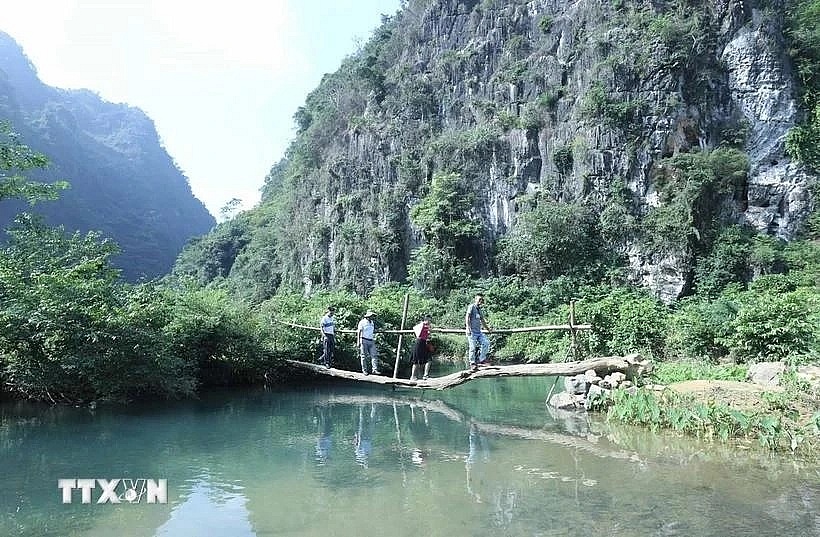Mountainous areas need more foreign investment to thrive
 |
| Tourists visit Yen Thinh commune of Huu Lung district, the northern mountainous province of Lang Son. (Photo: VNA) |
Hanoi – Aside from harnessing domestic resources, it is important to attract foreign investment to optimise potential and advantages of ethnic minority and mountainous areas, according to experts.
Such “soft” factors as limited knowledge, skills, and experience have affected foreign investment attraction in ethnic minority and mountainous areas, they said.
Hoang Van Xo, Director of the Department of International Cooperation at the Government’s Committee for Ethnic Minority Affairs (CEMA), said there are 53 ethnic minority groups with 11.7 million people residing in 52 provinces and cities nationwide, accounting for over 11% of the total population.
Developing ethnic minority areas is a consistent priority policy of the Vietnamese Party and Government, he affirmed.
Xo noted that the biggest asset of ethnic minority communities is the 8 million working-age people, so a measure for eliminating poverty there is promoting human resources training.
Hong Sun, Chairman of the Korean Chamber of Commerce in Vietnam (KOCHAM), said businesses from the Republic of Korea (RoK) has invested in some mountainous provinces such as Cao Bang, Lai Chau, Dien Bien, and Bac Kan, but the investment value remains modest.
He perceived that in the investment promotion for ethnic minority and mountainous areas, it is necessary to select projects that suit local conditions. For example, northern midland and highland localities should not call for investment in the semiconductor sector but hi-tech agriculture.
The distance between urban and mountainous areas in Vietnam is too big, Hong pointed out, adding that one of the biggest barriers is the incomplete transport infrastructure.
Therefore, CEMA should coordinate with the Ministry of Planning and Investment to mobilise more resources for developing infrastructure and human resources, the KOCHAM executive suggested.
Echoing the view, Morimoto Yutaka, Chairman of the Japanese-invested Accord Biz Co. Ltd, recommended mountainous provinces focus on attracting foreign investment to hi-tech agriculture to make use of local human resources and favourable natural conditions.
To do that, Vietnam needs to expand the logistics system, infrastructure and, especially, export markets, according to Yutaka.
To continue tapping into mountainous areas’ potential, CEMA’s Department of International Cooperation recently signed a strategic cooperation deal with the Institute of International Investment Studies Company (ISC) to support highland localities to improve foreign investment quality and effectiveness, and attract more investment.
Under the deal, the two sides will cooperate in equipping the localities’ cadres with legal knowledge, improving their foreign investment management and promotion skills, organising investment promotion activities, and giving advice on international investment cooperation.
Phan Huu Thang, Chairman of the ISC and the Vietnam Industrial Park Finance Association, described the agreement signing as an important step in mobilising international resources and experience to help with socio-economic development in ethnic minority and mountainous areas, local life quality improvement, as well as the country’s integration into the world.
 | FDI inflows rose by 13.1 per cent in H1 In the first half of the year, foreign direct investment (FDI) reported an increase of 13.1 per cent, while FDI disbursement also surged by 8.2 per cent on year. |
 | Stable growth in foreign inflows despite global dips Vietnam is reporting stable growth in foreign investments, deviating from global trends this year, thanks to the entry of some large-scale initiatives. |
What the stars mean:
★ Poor ★ ★ Promising ★★★ Good ★★★★ Very good ★★★★★ Exceptional
Related Contents
Latest News
More News
- Pivotal stage of growth paves way for rise in M&As (December 03, 2025 | 10:00)
- Positive projections for M&A interest from Thailand (December 03, 2025 | 09:40)
- Manifesting the first line of defence in cybersecurity (December 03, 2025 | 09:00)
- The transformational role AI can play in accounting arena (December 03, 2025 | 08:00)
- Unlocking 5G-AI potential in Singapore (December 03, 2025 | 08:00)
- Data-driven strategies vital for a fast-evolving nation (December 02, 2025 | 09:41)
- Policy to practice: how Vietnam can lead the region (November 26, 2025 | 16:03)
- Mobilising private capital at scale vital for climate battle (November 26, 2025 | 15:36)
- VILAF and Yoon & Yang launch Vietnam - Korea Practice Unit (November 26, 2025 | 15:16)
- Trademark disputes challenge foreign firms in Vietnam (November 24, 2025 | 15:30)

 Tag:
Tag:





















 Mobile Version
Mobile Version